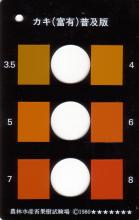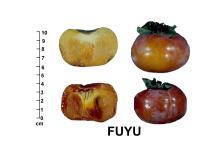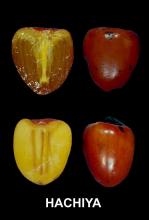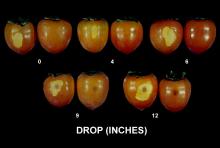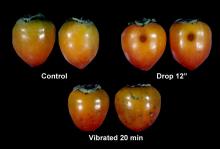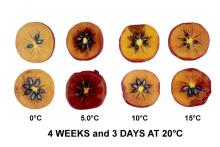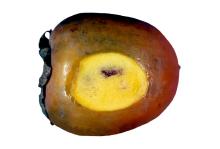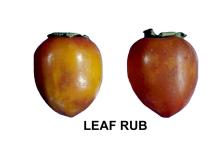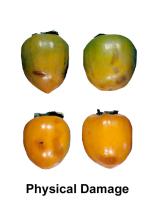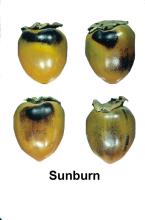Maturity and Quality
Minimum maturity is based on skin color change from green to orange or reddish-orange (Hachiya) or to yellowish-green or yellow (Fuyu, California Fuyu, Jiro).
- Yellow to orange color
- Medium to large size
- Firm (penetration force, using an 8-mm tip, is above 5 lb-force for 'Fuyu' and similar cultivars)
- Freedom from growth cracks, mechanical injuries, and decay
- Soluble solids of 21-23% in 'Hachiya' and 18-20% in 'Fuyu' and similar non-astringent cultivars
- No astringency (tannin content)
- Nutritive value: good source of carotenoids, vitamin A, vitamin C, and dietary fiber
Postharvest Handling and Storage
0 ± 1°C (32 ± 2°F)
Freezing point. -2°C (28°F); may vary depending on soluble solids content.
Chilling injury. 'Fuyu' and similar non-astringent cultivars are chilling- sensitive at temperatures between 5°C and 15°C (41°F and 59°F) and will exhibit flesh browning and softening. Exposure to ethylene aggravates chilling injury at these temperatures.
2-4 ml CO2/kg·hr at 0°C (32°F)
10-12 ml CO2/kg·hr at 20°C (68°F)
To calculate heat production multiply ml CO2/kg·hr by 440 to get Btu/ton/day or by 122 to get kcal/metric ton/day.
Persimmons are very sensitive to ethylene action. Exposure to 1 ppm and 10 ppm ethylene at 20°C (68°F) accelerates softening to less than 4 lb - force (limit of marketability) after 6 and 2 days, respectively. Thus, ethylene removal and/or exclusion from transport and storage facilities is highly recommended.
Removal of Astringency from 'Hachiya' Persimmons
Ethylene (10 ppm) at 20°C (68°F) can be used to remove astringency but the excessive softening that results would make it very difficult to market the persimmons. Exposure to air enriched with 80% CO2 for 24 hours at 20°C (68°F) is effective in removing astringency while maintaining firmness.
90-95%
>0.1 µl/kg·hr at 0°C (32°F) 0.1-0.5 µl/kg·hr at 20°C (68°F)
Responses to Controlled Atmospheres (CA)
- Low oxygen (3-5%) delays ripening
- Carbon dioxide at 5-8% helps retain firmness and can reduce chilling injury symptoms on 'Fuyu' and similar cultivars
- Postharvest life under optimum temperature and relative humidity in ethylene-free air can be up to 3 months vs. 5 months in optimum, ethylene-free CA (3-5% O2 + 5-8% CO2) conditions
Temperature & Controlled Atmosphere Photos
Title: Ethylene Effects
Photo Credit: Don Edwards, UC Davis
Disorders
- Exposure to oxygen levels below 3% during storage for longer than one month can result in failure of persimmons to ripen and in off-flavors
- Exposure to carbon dioxide levels above 10% during storage for longer than one month can cause brown discoloration of the flesh and off-flavors




